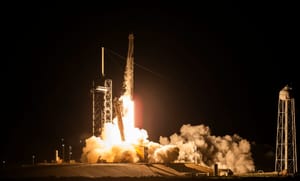
Sep 10, 2024
Polaris Dawn blasts off!
After a few weather-related launch scrubs, Polaris Dawn lifted off from Launch Complex 39A atop of Falcon 9 at 09:23 am, Universal Coordinated Time, on September 10th. Crew Dragon C207 'Resilience' separated from Falcon 9 at T+12:16 after being delivered to a 195 by 1200 kilometer orbit.
Falcon 9 launches @PolarisProgram's Polaris Dawn, Dragon’s 14th human spaceflight mission pic.twitter.com/DCd0s0Tl8P
— SpaceX (@SpaceX) September 10, 2024
Falcon 9 lifting off from Launch Complex 39A carrying Polaris Dawn, via SpaceX on X.
Now in orbit, the crew will begin pre-breathe over two days before performing a spacewalk out of the front of Crew Dragon as soon as September 12th.
The suits for this spacewalk were developed by SpaceX and based off of the Crew Dragon intravehicular space suits. These suits are more flexible for greater mobility, use better thermal management materials, and have a 'state-of-the-art' heads-up display inside the helmet.
Alongside the spacewalk, the mission will also test communications between Crew Dragon and Starlink, SpaceX's low Earth orbit internet mega-constellation. Thirty-six experiments are also onboard, according to SpaceX.
Crew Dragon has been modified to support a spacewalk from the spacecraft. SpaceX has swapped out the docking port on the front of the vehicle with its 'Skywalker' structure. 'Skywalker' will help the crew exit Crew Dragon, and move back inside after the spacewalk.

The Crew Dragon spacecraft for the Polaris Dawn mission is C207 'Resilience'. This is the third time 'Resilience' is heading to space, having previously flown for Crew-1 and Inspiration4.
Supporting the launch of Polaris Dawn was booster B1083. B1083 was flying for the fourth time, and successfully landed on the drone ship 'Just Read The Instructions' downrange.

Who's flying on Polaris Dawn?
Jared Isaacman
Jared Isaacman is the Mission Commander for Polaris Dawn. Isaacman is the only member of the crew to have traveled into orbit before, he previously commanded the Inspiration4 mission in 2021.
Within Earth's atmosphere, Isaacman has over 7,000 hours of flight experience in various experimental and ex-military aircraft. In these aircraft, he has performed two 'speed around the world' flights to raise money for charity, as well as participating in over one hundred airshows.

Scott Poteet
Scott “Kidd” Poteet is the Mission Pilot for the Polaris Dawn mission. This will be his first trip to space.
Poteet is also a retired United States Air Force Lieutenant Colonel who served 20 years in various roles including Commander of the 64th Aggressor Squadron, USAF Thunderbird #4 Demonstration Pilot, USAF Weapons School Graduate, Operational Test & Evaluation Pilot, and Flight Examiner. During his time flying within the atmosphere, Poteet has over 3,200 hours of flight experience in aircraft such as the F-16, A-4, T-38, T-37, T-3, and Alpha Jet.

Sarah Gillis
Sarah Gillis is the Mission Specialist for the Polaris Dawn mission. This will be her first trip to space.
Gillis is a Lead Space Operations Engineer at SpaceX, and is responsible for the company's training of NASA and commercial astronauts training with the Crew Dragon spacecraft. On Earth, she has supported operations for cargo resupply missions to and from the International Space Station and as a crew communicator for human spaceflight missions

Anna Menon
Anna Menon is the Mission Specialist and Medical Officer for the Polaris Dawn mission. This will be her first trip to space.
Menon is also a Lead Space Operations Engineer at SpaceX and manages the development of crew operations, as well as working in mission control as both a Mission Director and crew communicator. While at SpaceX, she has been in mission control for the Demo-2, Crew-1, CRS-22, CRS-23, Crew-3, Crew-4, and Axiom-1 missions, while also developing responses to emergencies with Crew Dragon, like depressurization and fires.

What is Crew Dragon?
Crew Dragon, or Dragon 2, is a partially reusable spacecraft developed by SpaceX. The primary use for Crew Dragon is to send crew to and from the International Space Station. SpaceX also performs free-flight missions with the spacecraft.

Crew Dragon consists of the capsule and trunk. The trunk is used to store unpressurized cargo as well as have solar panels mounted on one side, to generate power, and radiators on the other, to dissipate heat generated inside. The trunk is not reused and burns up in the atmosphere after each mission. The capsule is where the crew will be during launch, landing, and while on their way to space. Unlike the original Dragon capsule, the Crew Dragon capsule has a launch abort system consisting of eight SuperDraco engines. The capsule also has a nosecone that will fold out of the way in space to protect the docking hardware and forward-facing thrusters during launch and landing. The forward-facing thrusters are the main propulsion system for performing maneuvers while in flight.
Crew Dragon was developed as part of NASA's Commercial Crew Program to regain crew access to the International Space Station from the United States of America after the retirement of the Space Shuttle. SpaceX currently has four active Crew Dragon capsules; Endeavour, Resilience, Endurance, and Freedom. A fifth Crew Dragon capsule is under construction and is expected to be finished in 2024.



